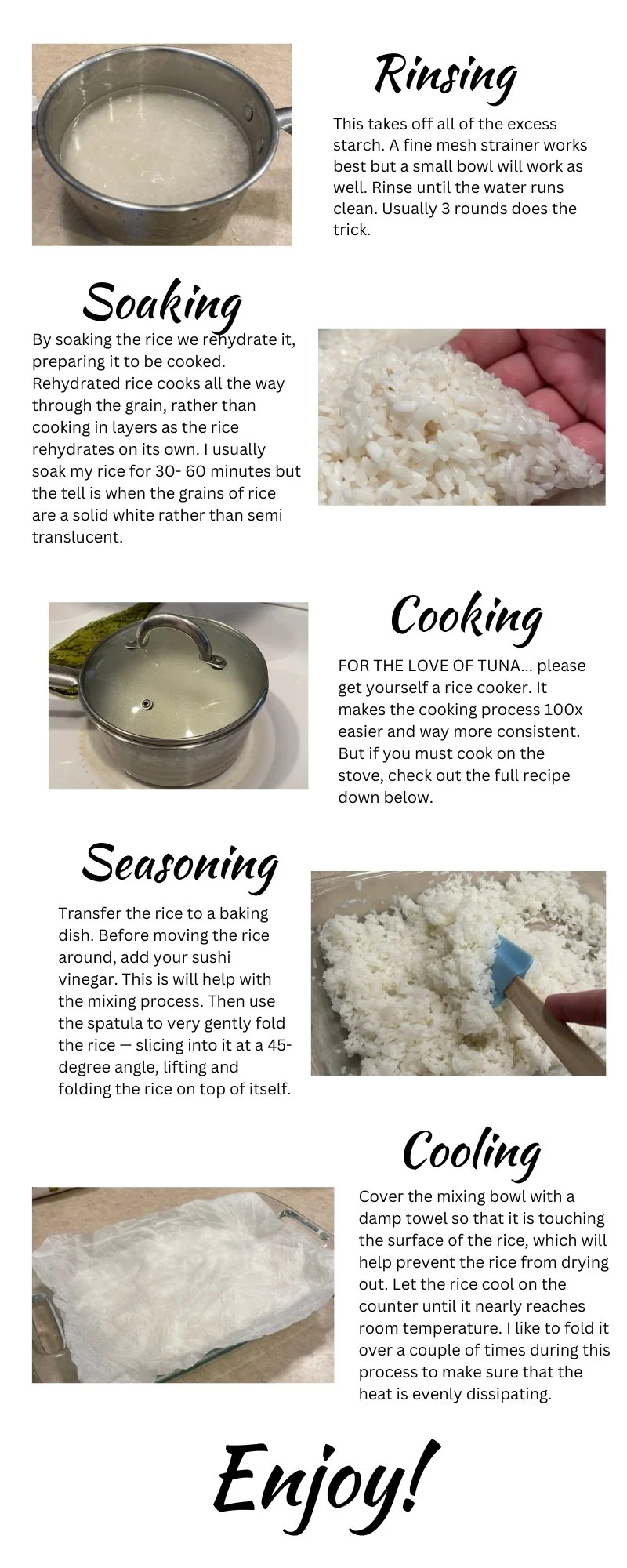The Pursuit Of Perfect Sushi Rice
They say a sushi master must spend 10 years training before they can claim the title of Itamae, most of which is spent making rice. I never really understood how something so seemingly simple could possibly take years to master. Then I tried good sushi rice for the first time...
Our sushi rice goes through 5 steps before its ready. Rinsing, soaking, cooking, seasoning, and cooling. Practice makes perfect so don’t be frustrated if at first you don’t knock it out of the park. Follow along and let’s work to perfect your sushi rice skills!
The Sensei’s Sushi Rice
1 cup dry short grain sushi rice (calrose is an excellent alternative)
1 cup water
1/4 cup rice vinegar
4 tsp sugar
1 tsp salt
As a general rule 1 cup of dry rice is going to make 3 cups of cooked rice. We use 2 cups of cooked rice in our class as a good measure of how much rice you will need but I recommend making more than this as it is terrible to run out of rice when you're making sushi.
So the math for 6 people looks like:
6 people x 2 cups cooked rice= 12 cups of cooked rice
12 cups cooked / 3 cups cooked to raw ratio = 4 cups raw rice.
I would cook 4 cups of raw sushi rice to make sushi with 6 people!
Rinse the rice. This takes off all of the excess starch. A fine mesh strainer works best but a small bowl will work as well. Rinse until the water runs clean. Usually 3 rounds does the trick
Soak the rice. By soaking the rice we rehydrate it, preparing it to be cooked. Rehydrated rice cooks all the way through the grain, rather than cooking in layers as the rice rehydrates on its own. I usually soak my rice for 30- 60 minutes but the tell is when the grains of rice are a solid white rather than semi translucent.
Cook the rice. A rice cooker works best here because they have preset white rice settings that are very consistent. If you're using a stove top add an extra splash of water to account for steam loss. Less than 1/4 cup.
*Stovetop instructions.* Briefly stir together the rice and water in a large saucepan, then cover the saucepan with a lid. Turn the heat to medium-high and until the water just reaches a simmer. Reduce heat to low to maintain the simmer, and cook for 16-18 minutes or until all of the liquid is absorbed. Remove the saucepan from the heat (with the lid still on) and let the rice steam for an additional 10 minutes. Note: Stovetop instructions can vary greatly as environment/cooking method/ heat are all variables. This recipe should get you close but it will require some fine tuning.
Make the sushi vinegar. Then while the rice is cooking, heat the vinegar, sugar and salt and whisk until the sugar has dissolved. You can either do this in the microwave or in a small saucepan on the stove.
Season the rice. Transfer the rice to a baking dish. (Usually you will want to use a Hangiri which is a wooden bowl but that is for the pros.) Note: If you are using a glass or metal dish, reduce the sushi vinegar from 1/4 cup to 3 TBS. Before moving the rice around, add your sushi vinegar. This is will help with the mixing process. Then use the spatula to very gently fold the rice — slicing into it at a 45-degree angle, lifting and folding the rice on top of itself, rather than stirring and crushing the rice — until the vinegar is evenly mixed in.
Cool. Cover the mixing bowl with a damp towel (I prefer a paper towel) so that it is touching the surface of the rice, which will help prevent the rice from drying out. Let the rice cool on the counter until it nearly reaches room temperature. I like to fold it over a couple of times during this process to make sure that the heat is evenly dissipating.


